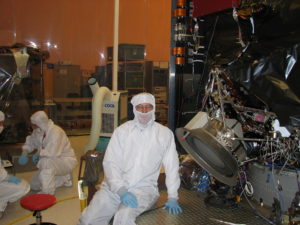The National Aeronautic Association has named the NASA Dawn Mission Team the winner of the 2015 Robert J. Collier Trophy. Colorado State University mechanical engineering alumnus John Brophy is a member of that team and was responsible for developing of the ion propulsion system used on the nearly decade-long Dawn Mission, enabling it to visit the two heaviest main belt asteroids – the giant asteroid Vesta and the dwarf planet Ceres. Brophy received his master’s degree in 1980, and his Ph.D. in 1984.

Launched in September 2007, Dawn is currently orbiting Ceres. The mission’s goal is to gather data from Vesta and Ceres, bodies believed to have formed early in our solar system’s history, to shed light on the characteristics of our early solar system and the processes that dominated its formation. Dawn is the first spacecraft in history to visit two extraterrestrial bodies, made possible by revolutionary ion propulsion breakthroughs developed by Brophy and his team.
This honor is awarded to only the greatest achievers in aeronautics or astronautics in the U.S. with respect to improving the performance, efficiency, and safety of air or space vehicles. Previous winners have included Orville Wright in 1913, the crew of Apollo 11 in 1969, Global Positioning System in 1992, and the Mars Science Laboratory in 2012, just to name a few – and now John Brophy and the rest of the Dawn Mission Team can add their names to this impressive list of pioneers.
Ion propulsion
What makes ion propulsion so groundbreaking? It allows us to reach farther and deeper destinations in space on spacecraft that use an unlimited source of energy from the sun.
Traditionally, deep space missions are made on chemical rockets with limited energy available; however, this mission was carried out on an ion propulsion system using an external energy source, the sun.
For Dawn’s mission, Brophy’s lab, at the NASA-Jet Propulsion Laboratory, developed a propulsion system that collects energy using large solar arrays and converts it into electricity, which is then run through the thrusters allowing for unlimited energy sent to the propellant. The propellant releases from the spacecraft at a speed 10 times higher than previous rocket engines resulting in a spacecraft that is 10 times more fuel-efficient.
It all started here
Before this technology was recognized by NASA and used on the Deep Space 1 and Dawn missions, Brophy had many trials and tribulations with ion propulsion technology. Brophy became interested in ion propulsion in graduate school at CSU where he was a student of ME professor emeritus, Dr. Paul Wilbur. Upon graduation in 1980, Brophy got a job at the Marshall Space Flight Center and worked on a project called the Solar Electric Propulsion System, with the goal of building an ion propulsion spacecraft using mercury as the propellant. The project never came to fruition, in part, because of mercury’s environmental disadvantages.
The ion propulsion system used on Dawn runs on xenon as the propellant, an environmentally safe alternative. Ion propulsion systems have actually been around for a long time; however, it’s challenging to make an ion thruster last long enough to be useful, and it’s also difficult to master the blend of elements used to make ion propulsion successful.
From CSU to JPL
After the ion propulsion system development at Marshall was canceled, Brophy once again collaborated with Dr. Wilbur at CSU for his Ph.D. to gain a better understanding of ion thrusters. After completing his Ph.D. in 1984, he joined JPL and eventually became the project element manager for Dawn’s ion propulsion system development.
In the early 1990s, Brophy convinced NASA’s New Millennium Program, which was designed to flight-test new technologies, that flight-testing an ion propulsion system was the most important thing it could do. Finally, in 1998, the New Millennium’s Deep Space 1 spacecraft was successfully tested on an ion propulsion system, and this set the groundwork for flying Dawn using ion propulsion.
The Deep Space 1 spacecraft spent about 16,000 hours in space, but Dawn shattered that record at about 50,000 hours in space – the longest- ever operation of a propulsion system in deep space. It became the highest-powered spacecraft that JPL had ever built for a deep space mission. Dawn’s ion propulsion system provided a far larger change in velocity to the spacecraft than any propulsion system in history.